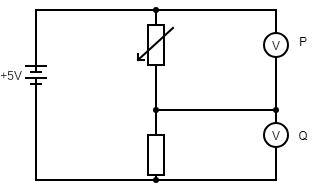
The diagram shows a potential divider circuit.
The resistance of the variable resistor is increased.
Which row shows what happens to the reading on voltmeter P and on voltmeter Q?

(A) Reading on Voltmeter P – decreases, reading on voltmeter Q-decreases
(B) Reading on Voltmeter P – decreases, reading on voltmeter Q-increases
(C) Reading on Voltmeter P – increases, reading on voltmeter Q-decreases
(D) Reading on Voltmeter P – increases, reading on voltmeter Q-increases
Answer
220.5k+ views
Hint: Note the circuit diagram carefully. Using ohm’s law, find the relation between voltage and resistance of the circuit. Voltmeter P is connected to the part of circuit majorly influenced by the variable resistor , whereas the voltage in Q is impacted by both the normal resistor and the variable resistor. Find the value changes using this logic.
Complete step by step solution:
It is given that the circuit is a potential divider circuit. It is a type of passive circuit which produces output voltage as a fraction of its input voltage. It is mainly implemented to distribute voltage across the circuit. Now let us assume in our given circuit, the emf of the circuit as E. The resistance in the variable resistor as r and the resistance in the fixed resistance as R.
Now, when the resistance of the variable resistor is increased, the voltmeter reading in the voltmeter P will increase, by virtue of ohm's law, which states that the potential difference across the circuit is directly proportional to the current flowing in the circuit.
\[V = Ir\]
Now, as r value increases, V value at P increases. Now, since the value of the other resistor is fixed, it will adjust itself so that the total voltmeter value is equal to that of the EMF of the circuit. Since voltmeter at P increases, the voltmeter at Q decreases to bring the overall value equal to that of EMF.
Hence, option (c) is the right answer for the given question.
Note: Terminal voltage is given as the potential difference that is observed across the terminals of the source battery. It is said that if the battery is not connected with the circuit, then the observed terminal voltage is equal to that of EMF of the battery. The voltmeter is used to measure the voltage across the circuit and can also be used to measure terminal voltage.
Complete step by step solution:
It is given that the circuit is a potential divider circuit. It is a type of passive circuit which produces output voltage as a fraction of its input voltage. It is mainly implemented to distribute voltage across the circuit. Now let us assume in our given circuit, the emf of the circuit as E. The resistance in the variable resistor as r and the resistance in the fixed resistance as R.
Now, when the resistance of the variable resistor is increased, the voltmeter reading in the voltmeter P will increase, by virtue of ohm's law, which states that the potential difference across the circuit is directly proportional to the current flowing in the circuit.
\[V = Ir\]
Now, as r value increases, V value at P increases. Now, since the value of the other resistor is fixed, it will adjust itself so that the total voltmeter value is equal to that of the EMF of the circuit. Since voltmeter at P increases, the voltmeter at Q decreases to bring the overall value equal to that of EMF.
Hence, option (c) is the right answer for the given question.
Note: Terminal voltage is given as the potential difference that is observed across the terminals of the source battery. It is said that if the battery is not connected with the circuit, then the observed terminal voltage is equal to that of EMF of the battery. The voltmeter is used to measure the voltage across the circuit and can also be used to measure terminal voltage.
Recently Updated Pages
Mass vs Weight: Key Differences Explained for Students

Young’s Double Slit Experiment Derivation Explained

Electricity and Magnetism Explained: Key Concepts & Applications

JEE Energetics Important Concepts and Tips for Exam Preparation

JEE Isolation, Preparation and Properties of Non-metals Important Concepts and Tips for Exam Preparation

JEE Main 2021 July 25 Shift 1 Question Paper with Answer Key

Trending doubts
JEE Main 2026: Application Form Open, Exam Dates, Syllabus, Eligibility & Question Papers

Understanding Uniform Acceleration in Physics

Derivation of Equation of Trajectory Explained for Students

Hybridisation in Chemistry – Concept, Types & Applications

Understanding the Angle of Deviation in a Prism

How to Convert a Galvanometer into an Ammeter or Voltmeter

Other Pages
JEE Advanced Marks vs Ranks 2025: Understanding Category-wise Qualifying Marks and Previous Year Cut-offs

Dual Nature of Radiation and Matter Class 12 Physics Chapter 11 CBSE Notes - 2025-26

JEE Main Marking Scheme 2026- Paper-Wise Marks Distribution and Negative Marking Details

Degree of Dissociation: Meaning, Formula, Calculation & Uses

Ideal and Non-Ideal Solutions Explained for Class 12 Chemistry

Understanding the Electric Field of a Uniformly Charged Ring




